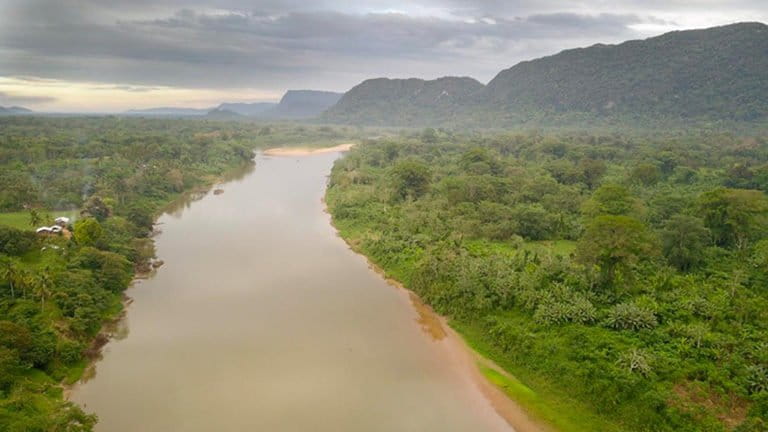- Jeremy Radachowsky, Director of the Mesoamerica and Western Caribbean Program at the Wildlife Conservation Society (WCS), writes about a recent expedition to the Miskitu indigenous territory called Bakinasta in the heart of Honduras’s Moskitia Forest.
- Radachowsky’s team entered the area before the COVID-19 epidemic started spreading widely through the Americas. By the time they exited the remote area, the world was a different place.
- Radachowsky says the Bakinasta territory, which is already under severe threat due to invasions by land grabbers, is being devastated economically by COVID-19. He’s calling on the global community to help indigenous peoples as they navigate this crisis.
- This article is a commentary. The views expressed are those of the author, not necessarily Mongabay.
Everyone’s lives have been upended by coronavirus, but perhaps nowhere have the impacts been as devastating as in Mesoamerica’s indigenous territories.
In March, just before the pandemic really hit the world, we traveled to the Miskitu indigenous territory called Bakinasta, in the heart of Honduras’s Moskitia Forest – Central America’s second largest rainforest.

The 103,000-hectare Bakinasta territory is under severe threat due to invasions by land grabbers looking to steal indigenous lands to establish illegal cattle estates. The goal of our visit was to establish and train an indigenous ranger team to protect their own territory.
Hiking deep in to the forest we encountered “carriles”, straight lines cut through the forest that invaders use to demarcate and lay claim to forest parcels for clearing and burning during the dry season. We also found a few recently felled trees. While tragic, these threats were expected, and the reason for our visit.
That evening, we camped on a beach at the edge of the river.

We knew that COVID was starting to have an impact across the world, but it seemed so distant. Lying on the sand, we stared in awe through binoculars at the beauty of the endless stars, and mused that the Moskitia Forest might be the best place to be in a pandemic – just about as far from the crowds as one could get.
On the four-hour river trip back we stopped to buy a watermelon. We made boats out of the melon rinds and threw rocks at them like children. We jumped in the river with all of our clothes on to wash off the mud, and did handstands as the current of the Patuca River pulled us along. We were in blissful ignorance.
It wasn’t long until we were close enough to the cell tower in Wampusirpe to be reconnected with the digital world. The emails started pouring in: “All non-essential travel prohibited”, “all nonessential staff to work remotely effective immediately.” The news told stories of flights being canceled, borders closing, the world shutting down.
After a Cessna flight to La Ceiba and an impromptu eight-hour drive, we made it back to Tegucigalpa just after midnight. When we pulled up to the airport the next morning, the doors were wrapped in caution tape. We feared that we were too late – that the airport had shut down – but were relieved to finally finding one guarded entry door that was still open.
I made my flight—one of the last to leave Honduras before flights were grounded—and transited through an eerily empty Atlanta airport. Despite the close call, I finally made it back home to my family.

However, Mesoamerica’s Indigenous Peoples were not so lucky. We could never have foreseen the breadth and depth of COVID-19’s impacts on local communities.
Nearly half of Mesoamerica’s Five Great Forests are governed by Indigenous Peoples and traditional communities who have lived and worked sustainably in them for centuries. In one sense, you’d expect this dependency on nature and remoteness to buffer such communities from a plague.
Yet COVID-19 has hit these communities hard, not only exposing them to the disease and cutting off access to food and supplies, but also suddenly shutting down key income sources such as sustainable timber, non-timber forest products, and ecotourism.
COVID-19 is not the only threat ravaging the region. In this fifth consecutive year of severe drought, unscrupulous invaders have sabotaged community lands and adjacent protected areas by setting forest fires, taking advantage of the fact that most national governments are uniquely focused on the COVID-19 crisis.


As fires burn out of control, a smoky haze covers the entire region. The fires threaten to destroy the forest homes and livelihoods of Indigenous and traditional forest communities and pollute air across the region—increasing everyone’s susceptibility to COVID-19 mortality. The crisis also threatens wildlife and forest landscapes and watersheds that supply water to millions of people, affecting both rural and urban populations. Mesoamerica’s Indigenous territories are facing a “perfect” firestorm.
If coronavirus has taught us anything, it is that the human race must be wiser about the way we live on and with planet earth. By protecting forests, indigenous and forest communities provide a service to all of humanity, but humanity has not done enough to protect them. It is time we give back.

We need to help local people protect their forests and combat fires while COVID-19 leaves them without jobs, food, and with minimal capacity to respond. We need to provide food, supplies, and stipends for community fire brigades and rangers to combat fires and protect indigenous and community forests. We need to shield Indigenous Peoples from the rampant invasion and destruction of their autonomous territories.
Not only will this protect local communities in a time of dire need, but it will improve air quality for all Central Americans, and protect some of the world’s most important tropical forests for all of humanity.
Header image: Baby black howler monkey orphaned from its mother by fire. Photo: Edwin Godoy
